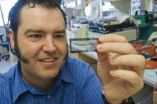(Press-News.org) ALBUQUERQUE, N.M. – Researchers at Sandia National Laboratories have developed a super-resolution microscopy technique that is answering long-held questions about exactly how and why a cell's defenses fail against some invaders, such as plague, while successfully fending off others like E.coli. The approach is revealing never-before-seen detail of the cell membrane, which could open doors to new diagnostic, prevention and treatment techniques.
"We're trying to do molecular biology with a microscope, but in order to do that, we must be able to look at things on a molecular scale," says Jesse Aaron, postdoctoral appointee at Sandia Labs.
The cell membrane is a bustling hub of activity on a miniscule scale. While providing structure and housing the cell's interior, the membrane regulates movement of materials in and out of the cell, controls adhesion to other objects and coordinates the cell's communications and subsequent actions through signaling. Receptor proteins on the surface of immune cells, known as toll-like receptors (TLRs), are tasked with recognizing intruders, or antigens. The TLR4 member of this receptor family responds to certain types of bacteria by detecting lipopolysaccharides (LPS) present on their surface. TLR4 proteins then alert the cell and activate an immune response.
Using imaging techniques they developed, Sandia researchers Aaron, Jeri Timlin and Bryan Carson discovered that TLR4 proteins cluster in the membrane when confronted with LPS derived from E.coli, which increases cell signaling and response. Interestingly, LPS derived from the bacteria that cause plague, Yersinia pestis, do not cause the same effects. This could explain why some pathogens are able to thwart the human immune system.
The plague studies marked the first time such small events have been imaged and compared, the Sandia researchers said. Previously, even the most sophisticated optical microscopes could not image the cell surface with enough spatial resolution to see the earliest binding events, due to the diffraction barrier, which limits what can be resolved using visible light.
"With more traditional visualization methods, you can't see the level of detail you need. It's important to look at not only what's present, but also when and where it's present in the cell," Timlin said.
The technique used by Timlin and Aaron builds on superresolution capabilities developed in recent years, but goes another step by adding dual-color capabilities to the relatively new stochastic optical reconstruction microscopy, or STORM. The combination enables the Sandia team to get a more complete picture by simultaneously imaging LPS and TLR4 receptors on the membrane.
"Current light microscopy capabilities are akin to looking out the window of an airplane and seeing the irrigation circles. You know that plants are there, but you can't tell what kinds of plants they are or what shape the leaves are," said Carson, a Sandia immunologist who was an integral part of the project. "But with this technology, it's like zooming in and seeing the leaves and the structure of the plants. That buys you a lot in terms of understanding what's happening within a cell and specifically how the proteins involved interact."
In 2009, the National Institutes of Health awarded Timlin a five-year, $300,000-a-year innovation grant. Next on the team's agenda is developing the capability to image live cells in real time using spectral Stimulated Emission Depletion, or STED. "We're working toward using a version of superresolution that's much more live-cell friendly, and extending that in terms of what colors are available to do multiple colors, while maintaining the live-cell friendliness. I see this as a beginning of a long development in this type of imaging technology," Timlin said.
Potential applications likely will expand as the technology reveals previously unattainable details of cell signaling. Eventually, the Sandia team would like to be able to visualize protein/protein interactions.
"Every biological process that goes on in your body is somehow controlled by proteins forming complexes with other proteins or complexes in the membrane, so this would give you this ability to look, with high spatial resolution and multiplexed color capabilities, at four or more things in a living cell, which can't be done very easily right now. It can be done in pieces, but we want to see the whole biological process," Timlin said.
The technology has exciting potential in immunology and drug discovery. Improved imaging could show the mechanisms viruses use to invade cells, which might lead to drugs that would block entry. "We're hoping to do something like label the viral particles and watch them in real time, or as close as we can to real time, in the internalization process," Carson said. "With the superresolution technique, we can actually watch them move through the membrane and see if there are other structures being recruited by the virus to the site of internalization."
Sandia originally developed the technology in support of its biological national security programs, but the team wants to expand the technology into other areas such as biofuels to better understand where and when different pigments are located on the membrane of oil-producing algae. This would provide valuable insight into their photosynthesis functions, which could lead to more efficient biofuel production.
"A lot of this work is in its early stages, but we're encouraged by what we're seeing and excited about its future potential," Aaron said.
### END
Sandia Labs unlocks secrets of plague with stunning new imaging techniques
2011-05-17
ELSE PRESS RELEASES FROM THIS DATE:
Surprising findings from studies of spontaneous brain activity
2011-05-17
New Rochelle, NY, May 16, 2011—Ongoing, intrinsic brain activity that is not task-related accounts for the majority of energy used by the human brain. This surprising finding, along with other recent discoveries about the brain and its function, structure, and organization, are described in "The Restless Brain," an Instant Online article in the groundbreaking new neuroscience journal Brain Connectivity, a bimonthly peer-reviewed journal published by Mary Ann Liebert, Inc. (www.liebertpub.com). "The Restless Brain," seven additional articles from the first issue, and a full ...
Monaco Grand Prix Package to be Won Courtesy of Purple Lounge and RakeTheRake.com
2011-05-17
To celebrate the launch of RakeTheRake's new website, there are three months of unique promotions to be won. Every week from now until the end of July 2011, there are some truly amazing prizes on offer for online poker players, all generously provided by RakeTheRake and their poker room friends. These special promotions are in addition to the regular $500k+ of monthly promotions. What's more, even players not currently tracked to RakeTheRake can enter!
This week there's the chance to win an incredible two day hospitality package to the Monaco Grand Prix in May 2012 thanks ...
Ohio residents: Medical and health research important to state's economy, jobs and incomes
2011-05-17
ROOTSTOWN, Ohio—May 16, 2011—Ohioans broadly support a strong commitment to medical and health research and recognize its direct link to job creation and the state's and the nation's economy, according to a new statewide poll conducted by IBOPE Zogby for Research!America and Northeast Ohio Medical University (NEOMED).
A strong majority of Ohioans (86%) thinks medical and health research is important—42% say very important—to the state's economy. Eight in 10 believe spending money on scientific research is important to Ohio's economy in terms of jobs and incomes.
Nine ...
A gene that fights cancer, but causes it too
2011-05-17
An international team of researchers, led by scientists at the University of California, San Diego School of Medicine, and the Eastern Hepatobiliary Surgery Hospital in China, say a human gene implicated in the development of leukemia also acts to prevent cancer of the liver.
Writing in the May 17 issue of the journal Cancer Cell, Gen-Sheng Feng, PhD, UCSD professor of pathology, and colleagues in San Diego, Shanghai and Turin report that an enzyme produced by the human gene PTPN11 appears to help protect hepatocytes (liver cells) from toxic damage and death. Conversely, ...
First Ever Lebanese Olive Trees Enter United States
2011-05-17
Corners of Time, a gourmet Mediterranean online marketplace, announces a first of its kind collaboration between Lebanon and California. In order to insure top quality olive oil and olive oil based products for its customers, Corners of Time has brought Lebanese olive tree cuttings into the United States. They are currently USDA quarantined at Novavine, an expert olive and grape nursery located in Sonoma County.
Four thousand years later, Corners of Time is completing the 16th century BC mission of its Lebanese ancestors, those adventurous Phoenician sailors who spread ...
ORNL energy harvesters transform waste into electricity
2011-05-17
OAK RIDGE, Tenn., May 16, 2011 – Billions of dollars lost each year as waste heat from industrial processes can be converted into electricity with a technology being developed at the Department of Energy's Oak Ridge National Laboratory.
The high-efficiency thermal waste heat energy converter actively cools electronic devices, photovoltaic cells, computers and large waste heat-producing systems while generating electricity, according to Scott Hunter, who leads the development team. The potential for energy savings is enormous.
"In the United States, more than 50 percent ...
Sporadic mutations identified in children with autism spectrum disorders
2011-05-17
Scientists at the University of Washington (UW) Department of Genome Sciences have identified several sporadic or "de novo" genetic mutations in children with autism spectrum disorder. The researchers applied leading edge molecular biology techniques and massively parallel sequencing to simultaneously examine all of the protein coding portions of the genome, collectively called the exome.
The research was published in advance online Sunday, May 15, in Nature Genetics.
The study was led by Dr. Brian O'Roak, senior fellow in the UW Department of Genome Sciences, and ...
Palin Prepares Plot for President?
2011-05-17
The author of the new book, "The Sarah Palin Rogue Revolution, Taking America By Storm", says he knows the answer.
The book, which explores Palin's 2012 aspirations, debuted in the best sellers in Kindle Political and Elections categories. Tony Reynolds, the author, says he answered the question, "is Palin is going to run for President in 2012?" by analyzing other political campaigns, such as those of President's Reagan, Bush, Clinton and Obama. As well as analyzing Independent campaigns such as H. Ross Perot and others.
This new book is available ...
Digital imaging software to create a 'Google Earth' view of the bladder
2011-05-17
Bladder cancer is the fourth-most-common cancer in men and one of the most expensive cancers to treat from diagnosis to death. After initial diagnosis and surgery, patients must return to the urologist at least yearly for a costly, time-consuming and uncomfortable bladder scan. Tumors recur in more than half of patients.
Researchers at the University of Washington are proposing a more automated approach that could be cheaper, more comfortable and more convenient for both doctors and patients. Their system would use the UW's ultrathin laser endoscope, which is like a thin ...
Lay-language summaries of latest research at Acoustical Society meeting now online
2011-05-17
College Park, Md. (May 16, 2011) – 'Feeling' sounds, muffling explosions and car exhaust, and 'hearing' damage to spacecraft are just some of the approximately 50 lay-language versions of papers being presented at the 161st Acoustical Society of America's (ASA) meeting in Seattle, Wash., May 23-27. These summaries are posted online in the ASA's Worldwide Pressroom; many contain evocative sounds, images, and animations.
Reporters attending the meeting or covering the sessions remotely now have access to a wide array of easily approachable summaries covering all aspects ...





